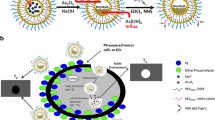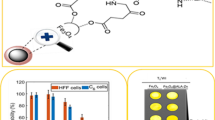Abstract
Cellular and nuclear uptake of dual labelled conjugates could be of great value for chemotherapy and cancer diagnostics. Therefore we designed conjugates in which gadolinium (Gd)-1,4,7,10-tetraazacyclododecane-1,4,7,10-tetraacetic acid (DOTA), a contrast agent for magnetic resonance imaging and fluorescein isothiocyanate (FITC), a fluorescence marker were coupled to membrane translocation sequences (MTS). The MTSs we employed were the third helix of the Antennapedia homeodomain, the HIV-1 Tat peptide and the N-myristoylated HIV-1 Tat peptide. We used confocal laser scanning microscopy, fluorescence activated cell sorting, magnetic resonance imaging (MRI) and viability tests to examine the cellular and nuclear uptake of these conjugates into U373 glioma cells, as well as their cytotoxic effects. We found that the Antennapedia conjugate was taken up by no more than 20% of the cells. The HIV-1 Tat conjugate showed even lower uptake into less than 3% of cells. Interestingly, N-myristoylation of the HIV-1 Tat conjugate drastically improved its cellular uptake. Up to 70% of cells showed cellular and nuclear uptake of the N-myristoylated HIV-1 Tat conjugate. Conjugate cytotoxicity appears to correlate with cellular uptake.



Similar content being viewed by others
References
Bhorade R, Weissleder R, Nakakoshi T, Moore A, Tung CH (2000) Macrocyclic chelators with paramagnetic cations are internalized into mammalian cells via a HIV-tat derived membrane translocation peptide. Bioconjug Chem 11:301–305
Christiaens B, Grooten J, Reusens M, Joliot A, Goethals M, Vandekerckhove J, Prochiantz A, Rosseneu M (2004) Membrane interaction and cellular internalization of penetratin peptides. Eur J Biochem 271:1187–1197
Derossi D, Joliot AH, Chassaing G, Prochiantz A (1994) The third helix of the Antennapedia homeodomain translocates through biological membranes. J Biol Chem 269:10444–10450
Derossi D, Calvet S, Trembleau A, Brunissen A, Chassaing G, Prochiantz A (1996) Cell internalization of the third helix of the Antennapedia homeodomain is receptor-independent. J Biol Chem 271:18188–18193
Desmeules P, Grandbois M, Bondarenko VA, Yamazaki A, Salesse C (2002) Measurement of membrane binding between recoverin, a calcium-myristoyl witch protein, and lipid bilayers by AFM-based force spectroscopy. Biophys J 82:3343–3350
Feldherr CM, Akin D (1990) The permeability of the nuclear envelope in dividing and nondividing cell cultures. J Cell Biol 111:1–8
Kruman II, Nath A, Mattson MP (1998) HIV-1 protein Tat induces apoptosis of hippocampal neurons by a mechanism involving caspase activation, calcium overload, and oxidative stress. Exp Neurol 154:276–288
Le Mignon MM, Chambon C, Warrington S, Davies R, Bonnemain B (1990) Gd-DOTA. Pharmacokinetics and tolerability after intravenous injection into healthy volunteers. Invest Radiol 25:933–937
Lukes I, Kotek J, Vojtisek P, Hermann P (2001) Complexes of tetraazacycles bearing methylphosphinic/phosphonic acid pendant arms with copper(II), zinc(II) and lanthanides(III). A comparison with their acetic acid analogues. Coord Chem Rev 216:287–312
Magerstadt M, Gansow OA, Brechbiel MW, Colcher D, Baltzer L, Knop RH, Girton ME, Naegele M (1986) Gd(DOTA): an alternative to Gd(DTPA) as a T1, 2 relaxation agent for NMR imaging or spectroscopy. Magn Reson Med 3:808–812
Minnicozzi M, Ramirez MM, Egan RW, Gleich GJ, Kobayashi I, Kim D, Duran WN (1995) Polyarginine and eosinophil-derived major basic protein increase microvascular permeability independently of histamine or nitric oxide release. Microvasc Res 50:56–70
Nelson AR, Borland L, Allbritton NL, Sims CE (2007) Myristoyl-based transport of peptides into living cells. Biochemistry 46:14771–14781
Prantner AM, Sharma V, Garbow JR, Piwnica-Worms D (2003) Synthesis and characterization of a Gd-DOTA-D-permeation peptide for magnetic resonance relaxation enhancement of intracellular targets. Mol Imag 2:333–341
Sankaram MB (1994) Membrane interaction of small N-myristoylated peptides: implications for membraneanchoring and protein-protein association. Biophys J 67:105–112
Sturzu A, Regenbogen M, Klose U, Echner H, Gharabaghi A, Heckl S (2008) Novel dual labelled nucleus-directed conjugates containing correct and mutant nuclear localisation sequences. Eur J Pharm Sci 22:207–215
Vaandrager AB, Ehlert EM, Jarchau T, Lohmann SM, de Jonge HR (1996) N-terminal myristoylation is required for membrane localization of cGMP-dependent protein kinase type II. J Biol Chem 271:7025–7029
Vivès E, Brodin P, Lebleu B (1997) A truncated HIV-1 Tat protein basic domain rapidly translocates through theplasma membrane and accumulates in the cell nucleus. J Biol Chem 272:16010–16017
Wender PA, Mitchell DJ, Pattabiraman K, Pelkey ET, Steinman L, Rothbard JB (2000) The design, synthesis, and evaluation of molecules that enable or enhance cellular uptake: peptoid molecular transporters. Proc Natl Acad Sci USA 97:13003–13008
Acknowledgment
The study was supported by the Hertie-Foundation for Brain Research.
Author information
Authors and Affiliations
Corresponding author
Rights and permissions
About this article
Cite this article
Sturzu, A., Klose, U., Echner, H. et al. Cellular uptake of cationic gadolinium-DOTA peptide conjugates with and without N-terminal myristoylation. Amino Acids 37, 249–255 (2009). https://doi.org/10.1007/s00726-008-0140-8
Received:
Accepted:
Published:
Issue Date:
DOI: https://doi.org/10.1007/s00726-008-0140-8




